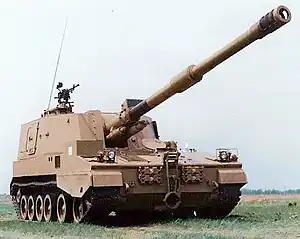| PLZ-45 | |
|---|---|
 Chinese PLZ-45 | |
| Type | Self-propelled artillery |
| Place of origin | China |
| Service history | |
| Used by | See § Operators |
| Wars | Yemeni Civil War (2014–present) |
| Production history | |
| Designer | Norinco |
| Designed | 1980s – early 1990s |
| Manufacturer | Norinco |
| Unit cost | $ 7.1 millions |
| Produced | 1997 |
| Specifications | |
| Mass | 33 tonnes[1] |
| Length | 10.5 m (34 ft 5 in)[1] |
| Width | 3.3 m (10 ft 10 in) |
| Height | 2.6 m (8 ft 6 in) with AAMG |
| Crew | 5 |
| Caliber | 155 mm |
| Traverse | 360° |
| Rate of fire | Maximum: 5 rounds/min Sustained: 2 rounds/min |
| Effective firing range | (HE) 24 km; (ERFB) 30 km; (ERFB-HB-BB) 39 km |
| Armor | Protection against small arms fire and artillery shell splinters |
Main armament | PLL-01 howitzer |
Secondary armament | 12.7 mm heavy machine gun 2 sets of 4-barrel grenade launchers |
| Engine | Deutz turbocharged air-cooled diesel engine 525 hp (391 kW) |
| Power/weight | 15 hp/tonne |
| Suspension | Torsion bar |
Operational range | 550 km (340 mi)[2] |
| Maximum speed | 55 km/h (34 mph) (on-road)[2] |
The PLZ-45 or Type 88 is a 155 mm self-propelled howitzer designed by Su Zhezi of 674 Factory, and developed by Norinco, 123 Factory (Heilongjiang Hua'an Industry Group Company), 127 Factory (Tsitsihar Heping Machine Shop), 674 Factory (Harbin First Machine Manufacture Limited Company) and the Beijing Institute of Technology in the early 1990s for the export market. It is based on Norinco's Type 89 (PLL-01) 155 mm/45-calibre towed gun-howitzer.[2][3]
The PLZ-45 self-propelled howitzer is used by the Chinese People's Liberation Army, the Algerian People's National Army, the Kuwait Army and the Saudi Arabian Army.
History
Noricum, the arms division of the Austrian steel company Voestalpine, purchased the design rights to the GC-45 howitzer after Space Research Corporation moved to Brussels. They made a number of detail changes to improve mass production, resulting in the GHN-45 (Gun, Howitzer, Noricum), which was offered in a variety of options like the APU and fire-control systems. Once out of prison, Gerald Bull was soon contacted by China.[4]
The PLA also used the Noricum version, producing it as the PLL-01, which entered service in 1987.[5][6] They also mounted it on a locally designed tracked chassis to produce the PLZ-45 (also known as the Type 88), along with an ammo-carrier based on the same chassis. The PLZ-45 did not enter service with the PLA primarily because their existing artillery was all based on Soviet-standard 152 mm ammunition. However, two major batches of PLZ-45s were sold to Kuwait and Saudi Arabia.
Design
Armament
Operated by a crew of five (commander, gunner, two loaders and a driver), the PLZ-45 is armed with a 155 mm, 45-calibre main gun, with a semi-automatic loader and an electrically controlled and hydraulically operated ram that enables projectile loading to take place at any angle of elevation with the charge being loaded manually. The turret has an elevation of +72 to –3 degrees with 360 degree traverse.[2]
Secondary weapons include a roof-mounted W-85 heavy machine gun and two sets of four-barrel smoke grenade launchers on the turret's side.
Ammunition is stored at the rear of the turret. A total of 30 rounds for the gun-howitzer and 480 rounds for the machine gun are carried on board. 24 howitzer rounds are carried in the loader and 6 rounds on the right side below the loader.
The fire-control system of the PLZ-45 includes an automatic laying system, optical sighting system, gun orientation and navigation system, and a GPS receiver.[2][3]
Munitions

The PLZ-45 howitzer fires a range of Extended Range Full Bore (ERFB) ammunition, including High Explosive (ERFB/HE), Base Bleed High Explosive (ERFB-BB/HE), ERFB-BB/RA, ERFB/WP, ERFB/Illuminating, ERFB/Smoke, and ERFB-BB/Cargo.[2][3]
China obtained the Russian Krasnopol laser-guided projectile technology in the 1990s, and successfully developed its own 155 mm laser-guided ammunition. Designed to defeat armoured vehicles and weapon emplacements, the projectile has inertial mid-course guidance and semi-active laser homing. The projectile has a range of 3–20 km (1.9–12.4 mi), and can hit a target by the first shot without registration.[2][3]
Combat
A standard PLZ-45 battalion consists of 3 batteries, each with 6 PLZ-45 self-propelled howitzers (SPH) and 6 PCZ-45 ammunition support vehicles (ASV). Each battery has a battery command post and 3 battery reconnaissance vehicles (BRV), both of which are based on the Type 85 APC. These are supported by W653A armoured recovery vehicles, 704-1 artillery locating and fire correction radar, 702-D meteorological radar, and fire support maintenance vehicles.[3]
Propulsion
The PLZ-45 self-propelled howitzer is powered by a 525 hp Deutz turbocharged air-cooled diesel engine, giving a max road speed of 55 km/h (34 mph).[7]
Armour and protection
The armour of the PLZ-45 self-propelled howitzer protects against small arms fire and artillery shell splinters. It is fitted with NBC protection and automatic fire suppression systems.[2]
Operational history
In April 2015, the Saudi Arabian Army used the PLZ-45 for shelling Houthi rebels along the Saudi Arabia–Yemen border during the Saudi Arabian–led intervention in the Yemeni Civil War.[8] This was the first time the PLZ-45 has been used in combat.[9] In late 2015, Kuwait sent an artillery battalion to Saudi Arabia to assist its Saudi ally against the Houthis.[10]
Operators

Current operators

 Algeria: 50 have been delivered.[8] First appearance was in 2014.[11]
Algeria: 50 have been delivered.[8] First appearance was in 2014.[11] China: Used by the People's Liberation Army.[12]
China: Used by the People's Liberation Army.[12] Ethiopia: 18 delivered in 1999.[13]
Ethiopia: 18 delivered in 1999.[13] Kuwait: (51) 27 PLZ-45s (to form a training platoon and the first battalion) ordered in 1998 and delivered in 2000–2001.[14][15] 24 more howitzers (to form the second battalion) were ordered in 2001 and delivered in 2002–2003.[14][15]
Kuwait: (51) 27 PLZ-45s (to form a training platoon and the first battalion) ordered in 1998 and delivered in 2000–2001.[14][15] 24 more howitzers (to form the second battalion) were ordered in 2001 and delivered in 2002–2003.[14][15] Saudi Arabia: (54) In 2007, it was reported that the Saudi Arabian Army had decided to order two battalions (54 units) of the PLZ-45 artillery system.[3] In August 2008, China signed a contract to provide Saudi Arabia with one battalion, i.e. 27 PLZ-45 155 mm self-propelled howitzers.[16][17] Another contract to supply one more battalion (27 more PLZ-45 self-propelled guns) was signed later in the month.[18] The howitzers were delivered between 2008 and 2009.[15]
Saudi Arabia: (54) In 2007, it was reported that the Saudi Arabian Army had decided to order two battalions (54 units) of the PLZ-45 artillery system.[3] In August 2008, China signed a contract to provide Saudi Arabia with one battalion, i.e. 27 PLZ-45 155 mm self-propelled howitzers.[16][17] Another contract to supply one more battalion (27 more PLZ-45 self-propelled guns) was signed later in the month.[18] The howitzers were delivered between 2008 and 2009.[15]
Potential operators
See also
References
- 1 2 "China Upgrades Self-Propelled Artillery". StrategyPage. 25 July 2010. Retrieved 20 April 2013.
- 1 2 3 4 5 6 7 8 "PLZ45 155-mm Self-Propelled Howitzer". Military-Today.com. Retrieved 18 April 2013.
- 1 2 3 4 5 6 "PLZ45 155mm Self-Propelled Gun-Howitzer". SinoDefence.com. 1 October 2008. Archived from the original on 5 November 2012. Retrieved 15 April 2013.
- ↑ Malone, William Scott; Halevy, David H.; Hemingway, Sam (10 February 1991). "THE GUNS OF SADDAM". The Washington Post. Retrieved 9 January 2020.
- ↑ O'Malley, T. J. (1 August 1989). "A general survey of recent artillery developments; refurbishment is the order of the day". Armada International. Archived from the original on 20 May 2011. Retrieved 16 June 2022 – via The Free Library.
- ↑ "PLL01 155mm Gun-Howitzer". SinoDefence.com. 28 March 2008. Archived from the original on 9 August 2011. Retrieved 11 March 2013.
- ↑ Pike, John (21 August 1999). "PLZ-45 self-propelled artillery". Military Analysis Network. Federation of American Scientists. Retrieved 16 June 2022.
- 1 2 "Saudi Arabia armed forces use Chinese-made PLZ45 155mm howitzer to fight rebels in Yemen 2604152". Army Recognition. 26 April 2015. Retrieved 16 June 2022.
- ↑ Lin, Jeffrey; Singer, P. W. (21 April 2015). "Saudis Use Chinese-made Cannons in Yemen". Popular Science. Retrieved 17 May 2015.
- ↑ "Kuwait to send troops to Saudi Arabia to fight Yemen rebels - newspaper". Reuters. 29 December 2015. Retrieved 16 June 2022.
- ↑ "Algeria acquires Chinese artillery; evaluating UAVs". defenceWeb. 27 January 2014. Retrieved 16 June 2022.
- ↑ Foss, Christopher F. (18 October 2012). "China details latest PLZ52 155 mm self-propelled artillery system". Jane's International Defence Review. Archived from the original on 8 July 2013. Retrieved 11 April 2014.
- ↑ "arms". Stockholm International Peace Research Institute. Retrieved 16 June 2022.
- 1 2 Cole, Stephen V. (24 November 2001). "Artillery Article Index - November 24, 2001". StrategyPage. Retrieved 19 April 2013.
- 1 2 3 "Trade Registers". Stockholm International Peace Research Institute. Retrieved 16 June 2022.
- ↑ Chang, Andrei (11 August 2008). "China to export guns to Saudi Arabia". Kanwa Daily News. Archived from the original on 28 September 2008. Retrieved 20 April 2013.
- ↑ Chang, Andrei (7 August 2008). "China wins key Saudi artillery contract". United Press International. Retrieved 15 April 2013.
- ↑ "Chinese Guns Conquer Arabia". StrategyPage. 15 August 2008. Retrieved 16 April 2013.
- ↑ Olimat, Muhamad (2012). China and the Middle East: From Silk Road to Arab Spring. Routledge. pp. 146–147. ISBN 978-1-135-10221-0.
